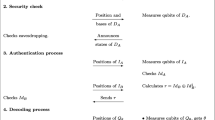Abstract
Since people realized that the principles of quantum mechanics, required microscopic systems to be changed upon observation can be exploited, quantum cryptography came into being which is brought an unconditionally secure way being applied to a variety of systems. Quantum key distribution is the most important application and the most widely used in quantum cryptography. In the classical cryptography, one time password is the most secure in theory, because the password is changed every time and the same password cannot be used at a later time. In this paper, we present a novel idea, which is applied the theoretical significance of one time password to quantum communication, one time basis. The basis automatically updates before each session ends based on the random number generated by the communication parties and two secure one-way functions, which resistances relay attacks and impersonation attacks.






Similar content being viewed by others
References
Diffie, W., & Hellman, M. E. (1976). New directions in cryptography. IEEE Transactions on Information Theory,22(6), 644–654.
Shamir, A. (1984). Identity-based cryptosystems and signature schemes. Lecture Notes in Computer Science,21(2), 47–53.
Cocks, C. (2001). An identity based encryption scheme based on quadratic residues. In IMA international conference on cryptography and coding (Vol. 2260(5), pp. 360–363)
Boneh, D., & Franklin, M. (2001). Identity-based encryption from the Weil pairing. In Proceedings of the 21st annual international cryptology conference on advances in cryptology. Society for Industrial and Applied Mathematics.
Sakaik, R., & Kasahara, M. (2003). ID based cryptosystems with pairing on elliptic curve. IACR Cryptology ePrint Archive.
Dutta, R., Barua, R., & Sarkar, P. (2009). Pairing-based cryptography: A survey.
Hancke, G. (2005). A practical relay attack on ISO 14443 proximity cards. Technical Report.
Rayes, M. O. (2011). One-time password. In Encyclopedia of cryptography and security. Springer, US.
Rubin, A. D. (1995). Independent one-time passwords. In Conference on USENIX UNIX security symposium (pp. 15). USENIX Association.
Paterson, K. G., & Stebila, D. (2010). One-time-password-authenticated key exchange. Lecture Notes in Computer Science,6168, 264–281.
Yang, S. S., & Choi, H. (2010). Vulnerability analysis and the practical implications of a server-challenge-based one-time password system. Information Management & Computer Security,18(2), 86–100.
Elliott, C., Pearson, D., & Troxel, G. (2003) Quantum cryptography in practice, pp. 227–238. arXiv.
Bennett, C. H. (1984). Quantum cryptography: Public key distribution and coin tossing. In International conference on computer system and signal processing (pp. 175–179). IEEE.
Mayers, & Dominic. (2001). Unconditional security in quantum cryptography. Journal of the ACM,48(3), 351–406.
Wiesner, S. (1983). Conjugate coding. ACM Sigact News,15(1), 78–88.
Zhang, P., Aungskunsiri, K., Martín-López, E., et al. (2014). Reference-frame-independent quantum-key-distribution server with a telecom tether for an on-chip client. Physical Review Letters,112(13), 1153–1165.
Wootters, W. K., & Zurek, W. H. (1982). A single quantum cannot be cloned. Nature,299(5886), 802–803.
Nielson, M. A., & Chuang, I. L. (2000). Quantum computation and quantum information (pp. 558–559). Cambridge: Cambridge University Press.
Broadbent, A., & Schaffner, C. (2015). Quantum cryptography beyond quantum key distribution. Designs, Codes and Cryptography,78(1), 351–382.
Zhu, H., Zhang, Y., & Wang, X. (2016). A Novel one-time identity-password authenticated scheme based on biometrics for e-coupon system. International Journal of Network Security,18(3), 401–409.
Preneel, B. (1999). The state of cryptographic hash functions. Lecture Notes in Computer Science,1561(1), 158–182.
Zhu, H. (2017). A novel two-party scheme against off-line password guessing attacks using new theorem of chaotic maps. KSII Transactions on Internet and Information Systems, 11(12), 6188–6204.
Burr, W. E. (2008). A new hash competition. IEEE Security and Privacy,6(3), 60–62.
Swan, M. (2015). Blockchain: Blueprint for a new economy. Sebastopol: O’Reilly Media.
Acknowledgements
This work was supported by the 2019 Liaoning Provincial Natural Science Foundation of China: “Research on privacy authentication mechanism and multi-party intelligent contract system based on blockchain technology”.
Author information
Authors and Affiliations
Corresponding author
Additional information
Publisher's Note
Springer Nature remains neutral with regard to jurisdictional claims in published maps and institutional affiliations.
Rights and permissions
About this article
Cite this article
Zhu, H., Wang, R. An Automatically Iterated One-Time Basis Authenticated Scheme Against Relay Attack. Wireless Pers Commun 109, 1863–1873 (2019). https://doi.org/10.1007/s11277-019-06656-9
Published:
Issue Date:
DOI: https://doi.org/10.1007/s11277-019-06656-9




